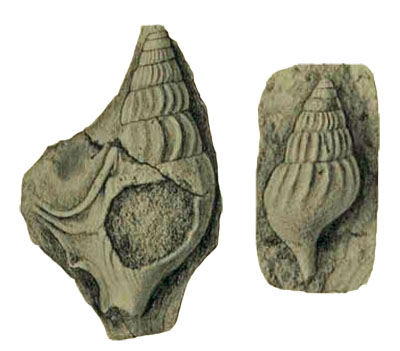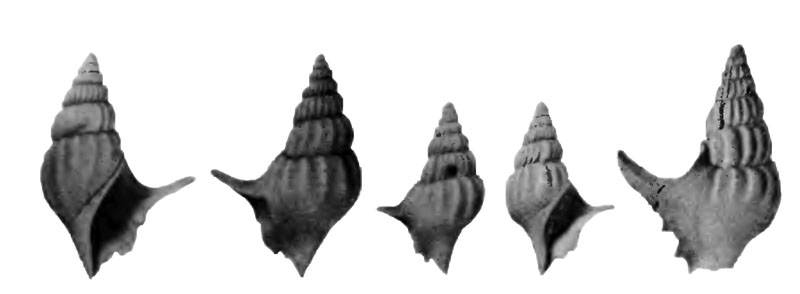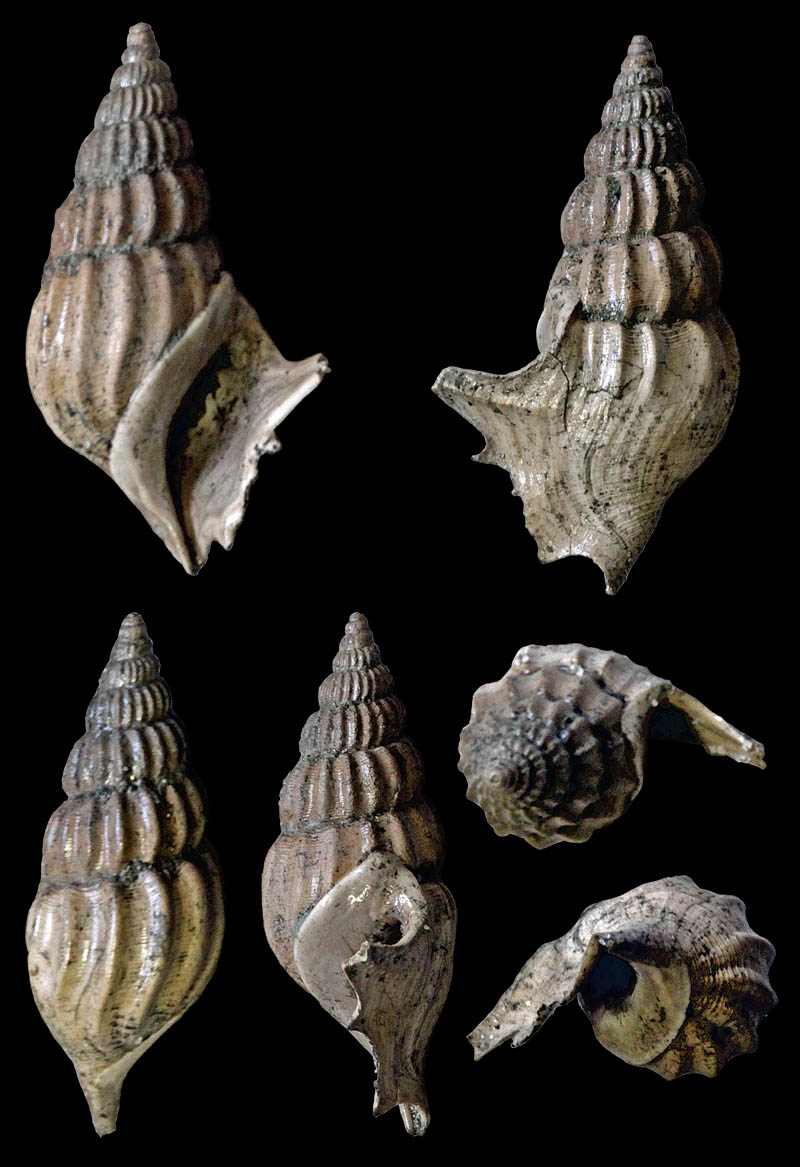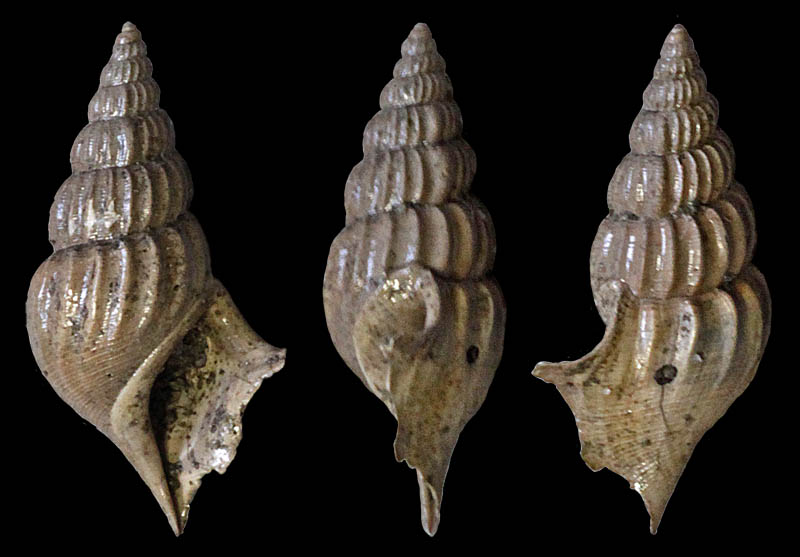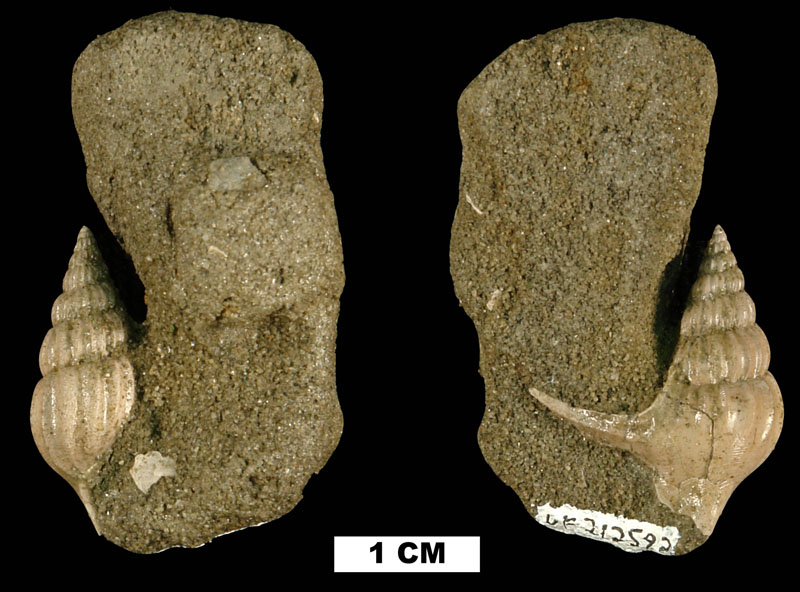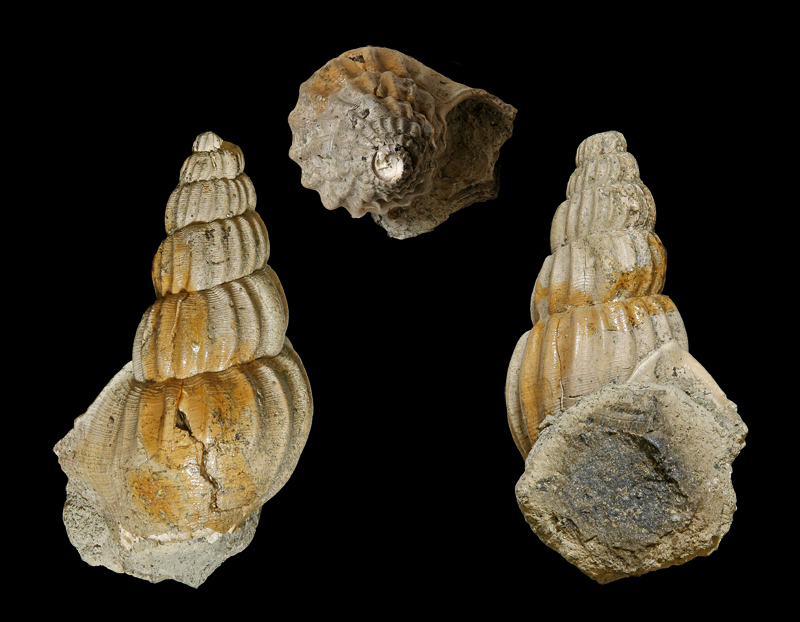Stromboidea
Original description of Anchura (Drepanochilus) calcaris by Wade, 1926
- "Shell smooth, fusiform in outline, with a spur-shaped outer lip; spire turreted, its elevation a little greater than half the total altitude of the shell; seven or eight whorls, increasing gradually in size; protoconch small and smooth, trochoid in outline and coiled three and a half times; sculpture elegant, consisting of both axials and spirals; axial costae strong, abruptly elevated, persisting from suture to suture on the whorls of the spire and extending partly over the anterior slope of the body; crests of the axials angular, about 17 upon the body; at irregular intervals the axial costae are enlarged and well rounded, varix-like in appearance, one or two occurring on each whorl of the spire; overridden by-many crowded microscopic spiral threads, which are absent on the crest of the varices; suture impressed; body slightly inflated and convex, produced in front into a narrow and pointed anterior canal; aperture lenticular, produced anteriorly into a narrow open canal; outer lip expanded into a long, gracefully upturned narrow projection that greatly resembles a cock's spur in outline; the ventral side of this expanded outer lip is longitudinally grooved; in front of this projection upon the anterior slope of the outer lip are two low tooth-like protuberances; inner lip excavated at the base of the body; columella smooth; parietal wall widely glazed with a callus that ends with a sharp margin on the body opposite the aperture."
Locus typicus: Dave Weeks place on Coon Creek, McNairy County, Tennessee, USA.
Stratum typicum: Ripley Formation, upper Cretaceous
History and Synonymy
1941
Original description of Anchura caddoensis by Stephenson, 1941:
- "Shell small for the genus. Spiral angle about 38 degrees. Whorls 6, evenly rounded, approaching plumpness. Axials numerous and prominent, but irregular in strength and spacing, an occasional one forming a non-prominent varix; the axials number 15 to 18 on each of the larger whorls; they decrease in size, but apparently not in number, on the successively smaller whorls toward the apex; in trend each axial is broadly concave toward the front and is a little oblique toward the front in its trend from above downward across the whorl. On the body whorl the axials fade out as they pass downward over the broadly rounded periphery onto the moderately constricted base. The surface is covered with fine closely spaced spiral ridges which override the axials. The aperture is elongated, ending posteriorly in an acute angle, and anteriorly in a narrow straight channel which is incomplete on all the available specimens. The outer lip expands and is projected above into a narrow upbent process, the maximum incomplete observed length of which is about 5 mm.; running centrally along this process is a ridge which passes backward onto the body whorl where it fades out within a few millimeters; the upper margin of the process is thickened and this thickening continues along the upcurved margin of the outer lip to the point where it joins with the upper margin of the inner lip; the lower obliquely sloping margin of the outer lip presents two downfolds, separated by a broader upfold; the downfolds are coincident with two short pointed projections of the margin. The inner lip is broadly excavated and spreads forward as a thin callus covering a band about 2 millimeters wide on the parietal wall in advance of the aperture. The columella as revealed in broken shells is twisted."
Locus typicus: Stevens place, 1 4/5 miles northeast of Quinlan, Hunt County, Texas, USA
Stratum typicum: Nacatoch sand, Navarro Group, Maastrichtian, upper Cretaceous
Holotype: U.S.N.M. no. 76923; height 18+ mm.; diameter including outer lip 11.6 mm., exclusive of outer lip about 7.8 mm.
Anchura caddoensis in Stephenson, 1941; Plate 56, fig. 3 and 4; left holotype U.S.N.M. no. 76923; right paratype U.S.N.M. no. 76924
- Image courtesy The University of Texas at Austin
1960
Graciliala calcaris in Sohl, 1960, pl. 11, fig. 1-4 and 6
- image courtesy of the U.S. Geological Survey
Comment of Sohl, 1960:
- Anchura caddoensis Stephenson, Nacatoch Sand = Graciliala calcaris Wade
Specimens from institutional collections
Graciliala calcaris (Wade, 1926); Ripley Formation, Maastrichtian, upper Cretaceous; Lake, Scott & Newton Counties, Mississippi, USA; Coll. Stichting Schepsel Schelp no. 54940
Graciliala calcaris (Wade, 1926); Ripley Formation, Maastrichtian, upper Cretaceous; Lake, Scott & Newton Counties, Mississippi, USA; Coll. Stichting Schepsel Schelp no. 54940
Graciliala calcaris (Wade, 1926); Dave Weeks place, Coon Creek Formation, Maastrichtian, Cretaceous; Coon Creek, Enville, McNairy County, Tennessee, USA; Coll. Florida Museum of Natural History UF 212592
Graciliala calcaris (Wade, 1926); Coon Creek Tongue, Selma Group, Ripley Formation, early Maastrichtian, Cretaceous; Mr. Dave Weeks' farm, on Coon Creek, 3.5 mi S of Enville and 7.5 mi N of Adamsville, McNairy County, Tennessee, USA; Coll. Yale Peabody Museum of Natural History IP 056472
Reference:

